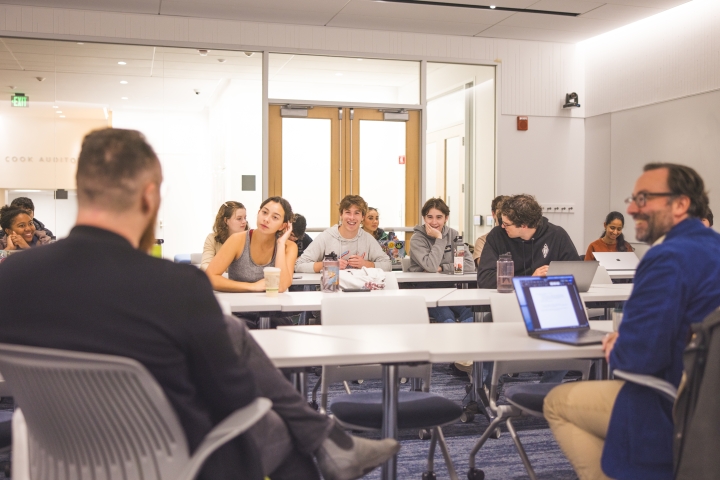With artificial intelligence steadily working its way into our digital lives and posing the prospect of an AI-fueled future, a new class offering, Critical AI, is introducing students to its history and examining the sociocultural impacts of the transformative technology.
The Department of English and Creative Writing class is being taught this fall by James “Jed” Dobson, an associate professor of English and creative writing and director of the Writing Program who has been appointed special advisor to the provost for artificial intelligence for 2024-25.
“The class looks at artificial intelligence from a humanities perspective, applying cultural critique to assess its impact, while understanding how these technologies came to be, how they work, and how they fail,” says Dobson, the author of several books and essays on computational methods including machine learning, computer vision, and data mining.
Through the term, the class has followed the history and development of AI from the fundamentals of neural networks and how they work for different applications to the emergence of generative AI that uses computer models trained to mimic human language to create text, image, video, and other content, says Dobson.
Students also consider critical questions about the data used to train models; biases that emerge from who curates and labels data; how the technologies are being used; and how they will impact society and culture. “We’re asking social questions at the same time that we’re thinking about technical questions such as what is involved in transforming an image or a section of text into data,” says Dobson.
“I think what has been most interesting to me is the thought around acknowledging labor in the making of AI,” says Sarah Williams ’25, who is majoring in anthropology modified with women’s and gender studies. “When we use OpenAI or ChatGPT, it’s not necessarily the machine or program that is producing the responses we ask for. It’s the hundreds (thousands) of data analysts, computer scientists, and historians who have done the work to make a produced response possible.”

Classes are a mix of lectures, hands-on lab sessions where students toy with pre-trained networks and analyze their performance, and guest lectures by experts in digital humanities from other universities.
Leif Weatherby, associate professor of German, founding director of the Digital Theory Lab, and director of digital humanities at New York University, spoke to the class on Oct. 31 and invited students to weigh in on a range of questions including what areas of their future life they think AI would affect, whether AI is intelligent, what they use generative AI for, and how we can make our systems better. The emerging field of critical AI is centered around asking “What’s really going on?” he said.
“This course has absolutely changed my understanding of AI,” says Dagny Scannell ’25, a senior majoring in biology with a minor in theater. “I didn’t previously know how AI models came to be, and I now am starting to see the importance of understanding the history and constraints of AI and machine learning,” says Scannell, who hopes to become a physician and is now excited to follow emerging AI technology in health care and medicine in a more informed way.
There are not too many courses that explore the intersection of English and computer science, says Nicholas Nikcevic ’27, who is majoring in both fields. He is astounded by how the seemingly simple idea of training large language models like ChatGPT to predict the next most likely word in a sequence has taken AI development so far.
“The course has made me excited about the potential of studying critical AI theory and thinking deeply about AI’s impact on various industries such as software engineering and comedy writing,” he says.
Students are quite interested in questions about policy and law related to AI, says Dobson. He was surprised by the widespread interest in the class. “I’ve got the greatest diversity of majors than most classes I’ve taught, which is great and exciting,” he says.
